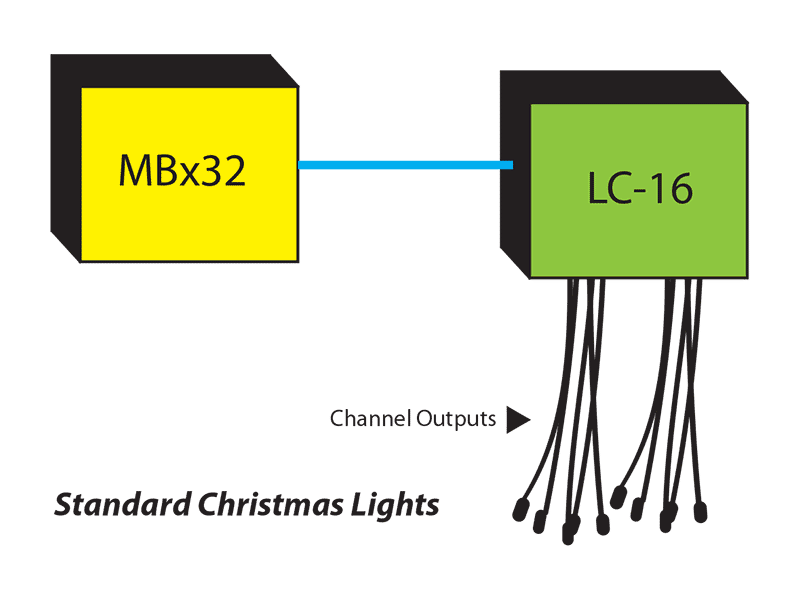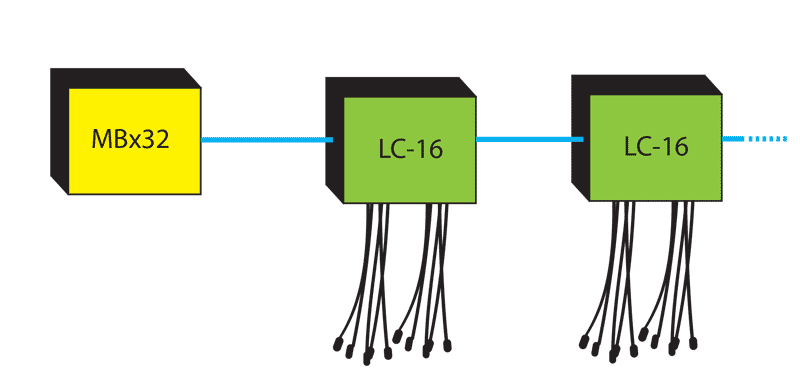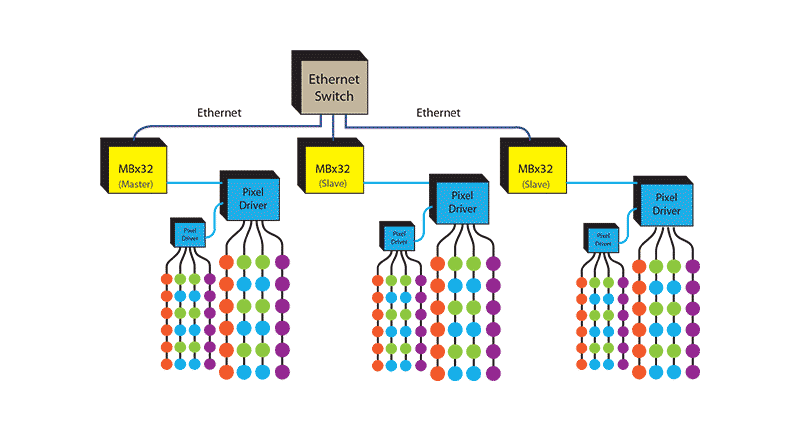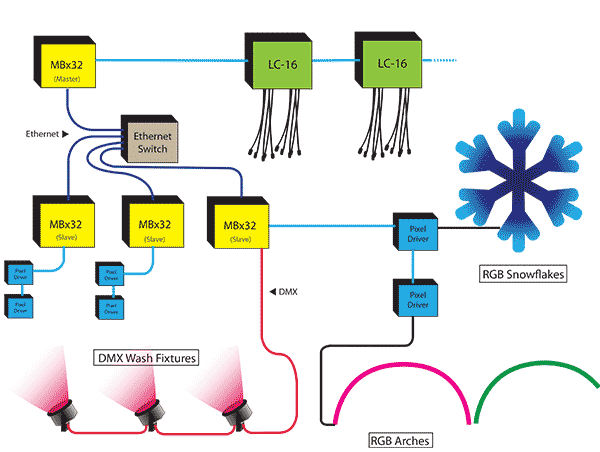Our Christmas in a Box product is what every customer starts with regardless of the size of the display, the lighting used, and the effects that are planned. Not sure what this product is? Check out this great introductory video (just three minutes long) that will provide you with an overview of the capabilities of this amazing product:
In addition to this video, we believe our Typical Network Configurations document that shows how you can start with the basic Christmas In a Box package and grow (and grow and GROW!) your display with additional products, different types of lighting, and even specialty applications is also very helpful.
Here, I will give an overview of how Animated Lighting displays can start small and grow over time using our Typical Network Configurations document as a guide:

This configuration is intended for starter residential displays and uses the basic Christmas In a Box package:
The next configuration expands the basic Christmas in a Box package by adding more LC-16 (light controllers for standard lighting).

Since our beginning in 2002, we have built our system to be expandable to include as many standard light controllers as needed. A common reason customers expand their displays with multiple controllers is to include one or more of the Just Add Power products that we offer. (Visit our Just Add Power section to learn more about these products.)
As you grow your display you just need to update the SD card to accommodate your growth.
The newest lighting technology on the market is called RGB Pixel lighting.
Imagine a string of lights where each bulb in the string has a red, green, and blue (or RGB) LED. By mixing these colors, each bulb can be any color of the rainbow with more than 16 million colors that are technically possible. In addition, imagine that each bulb on the string can be controlled on an individual basis.
Each bulb in this configuration is known as a “pixel”. These strings are “intelligent” because each bulb can be individually controlled. This gives you a virtually unlimited number of effects because neighboring pixels can be different colors.
Instead of the LC-16 light controller, RGB Pixel lighting requires a controller called a Pixel Driver. This configuration shows how you can connect from the Monster Brain (the same one as in the first 2 configurations) to up to two Pixel Drivers.

Each Pixel Driver can control up to 2,040 channels. At 510 channels per universe, that’s four universes worth of channels per Pixel Driver! As we said before, one Monster Brain can control two Pixel Drivers, which is eight universes of channels or 4,080 intelligent lighting channels!
A single MBx32 can be used to control BOTH the LC-16 controllers and the Pixel Drivers.
 This is a pretty common configuration with residential customers who want standard lighting for bushes and trees and Just Add Power products for items such as RGB Stars and Snowflakes and RGB Arches (very popular item). We offer a large library of preprogrammed shows/songs that combine standard lighting and RGB Pixel products.
This is a pretty common configuration with residential customers who want standard lighting for bushes and trees and Just Add Power products for items such as RGB Stars and Snowflakes and RGB Arches (very popular item). We offer a large library of preprogrammed shows/songs that combine standard lighting and RGB Pixel products.
For our customers that require more than two Pixel Drivers (or more than 4,080 lighting channels and eight DMX universes), we can network multiple Monster Brains together via an Ethernet switch.

The main Monster Brain is the “Master” and the additional Brains are referred to as “Slaves.” The master Brain sends commands to all the slaves. Very large installations can be achieved with this configuration. We actually have a project where we have one master and 25 slaves!

Theatrical lighting products, RGB outdoor-rated fixtures, fog and snow machines, lasers, and other DMX products can easily be incorporated into an Animated Lighting network. This section of the Typical Configurations document shows examples of this type of lighting being included in a network with standard lighting (LC-16 light controllers) and RGB Pixel lighting (Just Add Power) products.

There are two ways that a network can be controlled on a wireless basis:

The last configuration in this document shows how to run a lighting show live. This is a common occurrence for churches (effects that are synchronized to the singing of the choir) and nightclubs (effects that are changed by a DJ based on the tempo and the type of music) for example.
In this situation, a PC with lighting software is required. You also need an Animated Lighting DataBridge which connects the PC and the lighting. If you have an application such as this, please contact us at 816-941-0400 or Typical Network Configurations document to see which situation best describes you and be sure to contact us with any questions.